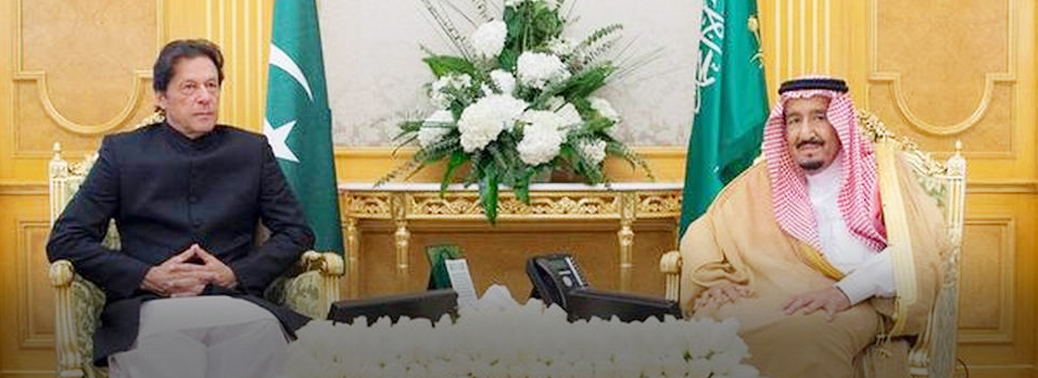Pakistan invites Saudi
12, Sep 2018

Prelims level :
Mains level : Paper-II Effect of policies and politics of developed and developing countries on India’s interest
Why in news?
- Saudi Arabia will be the third “strategic partner” of the $50 billion China-Pakistan Economic Corridor (CPEC), a senior Pakistani Minister announced, soon after Prime Minister Imran Khan returned from his first foreign trip to the cash-rich kingdom.
CPEC:
- China-Pakistan Economic Corridor(CPEC), massive bilateral project to improve infrastructure within Pakistan for better trade with China and to further integrate the countries of the region.
- The project was launched on April 20, 2015 when Chinese President Xi Jinping and Pakistani Prime Minister Nawaz Sharif
- The goal of CPEC is both to transform Pakistan’s economy—by modernizing its road, rail, air, and energy transportation systems—and to connect the deep-sea Pakistani ports of Gwadar and Karachi to China’s Xinjiang province and beyond by overland routes. (Xinjiang borders the countries of Mongolia, Russia, Kazakhstan, Kyrgyzstan, Tajikistan, Afghanistan, Pakistan, and India, and the ancient Silk Road ran through its territory.)
- This would reduce the time and cost of transporting goods and energy such as natural gas to China by circumventing the Straits of Malacca and the South China Sea.
- The announcement of joint space and satellite initiatives between Pakistan and China, spurred by CPEC, followed in 2016. CPEC is part of the larger Belt and Road Initiative—to improve connectivity, trade, communication, and cooperation between the countries of Eurasia—announced by China in 2013.
- CPEC has been compared to the Marshall Plan for the rebuilding of post-World War II Europe in its potential impact on the region, and numerous countries have shown interest in participating in the initiative.
India’s Going to Be Affected When CPEC Changes World Trade:
- The much-vaunted USD 54 billion economic corridor in Pakistan that connects the Xinjiang region in western China with the southern Pakistan port of Gwadar is gradually rolling off operations, with the Chinese cargo being loaded onto the merchant vessels docked at the port.
1. India’s Sovereignty
- India has continuously opposed the project since it passes through the Pakistan-occupied Kashmiri territory of Gilgit-Baltistan – a claim opposed by Pakistan.
- The 1,300-km corridor is also perceived to be an alternative economic road link for the Kashmir Valley lying on the Indian side of the border. Most key players in the Indian state of Jammu and Kashmir, including CM Mehbooba Mufti, have expressed optimism about the project.
2. Chinese Control Over Trade Via Sea
- Major US ports on the East Coast depend on the Panama Canal to trade with China. Once CPEC becomes fully functional, China will be in a position to offer a ‘shorter and more economical’ trade route (avoiding travel through the entire Western Hemisphere) to most North and Latin American enterprises.
- This will give China the power to dictate the terms by which the international movement of goods will take place between the Atlantic and the Pacific oceans.
3. Chinese String of Pearls
- China has been increasing its presence in the Indian Ocean with the ‘String of Pearls’ ambition: A term coined by the Americans and often used by Indian defence analysts to refer to a Chinese game-plan of encircling India through a network of airfields and ports.
- With an existing presence in Chittagong port (Bangladesh), Hambantota port (Sri Lanka), Port Sudan (Sudan), Maldives, Somalia and Seychelles, a control of Gwadar port establishes complete dominance of the Indian ocean by the Communist nation.
4. Emergence of Pakistan as an Outsourcing Destination
- Often referred to as the ‘Marshall Plan’ of China – named after a historic US plan to provide financial aid to western Europe in the aftermath of World War 2, which helped Europe rebuild itself – CPEC is poised to speed up Pakistan’s economic progress.
- Development of commercial towns adjoining the corridor and better rail and road connectivity enabling the movement of a skilled workforce from the hinterlands to the urban centres can help Pakistan emerge as a key destination for contract-manufacturing-outsourcing for the Eastern This is more probable at a time when India is becoming costlier and Bangladesh has performed poorly on quality and regulatory standards.
5. Stronger OBOR and Chinese Dominance in Trade Leadership
- China’s one-belt-one-road (OBOR) project that focuses on the trade connectivity between China and the rest of Eurasia through a network of ports, roads and railways has been often seen as China’s plan to dominate the region politically. CPEC is one giant step in the same direction.






